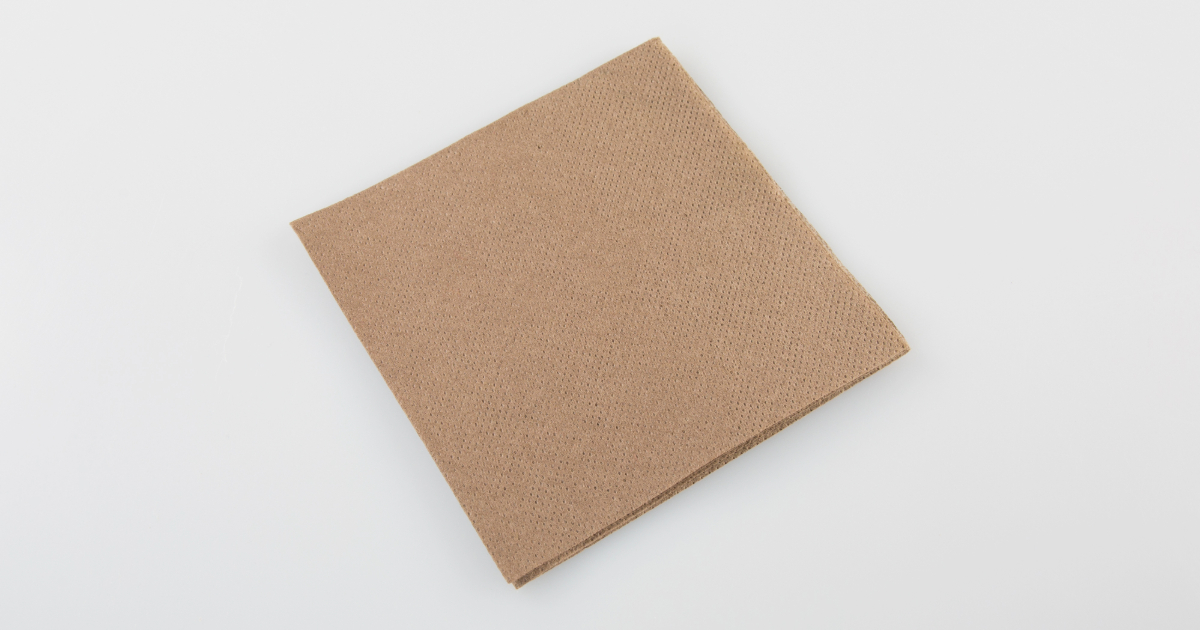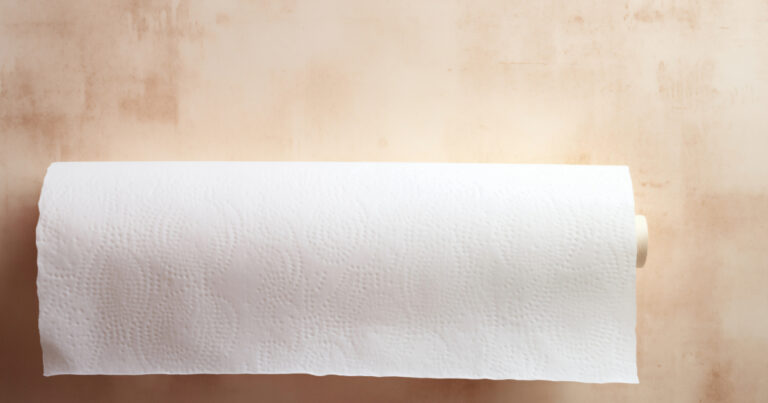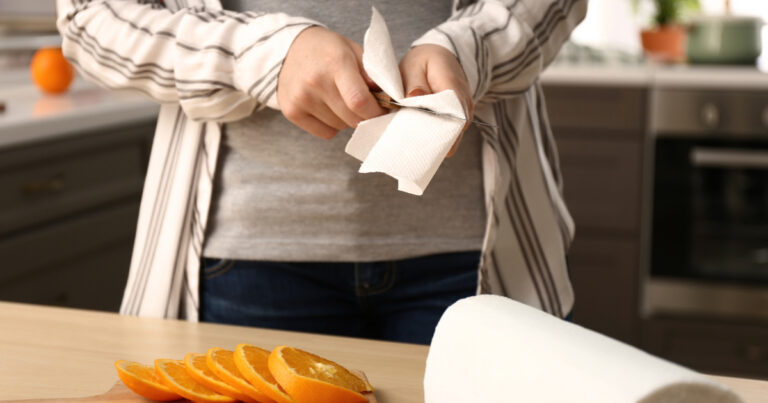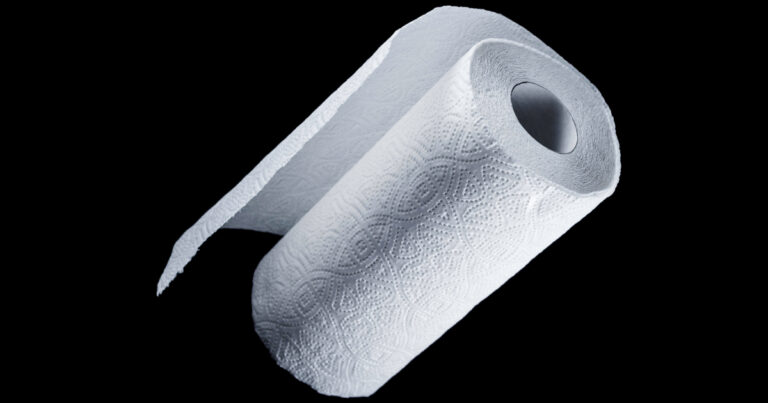Paper towels are a household staple used for cleaning, drying, and more.

When standing in the paper product aisle, you’ll typically see two main options – white paper towels and brown paper towels.
But what’s the difference between the two? Which is the better choice?
Brown vs. White Paper Towels: Key Differences
There are a few key differences between traditional white paper towels and brown paper towels:
Bleaching Process
The main difference lies in the bleaching process. White paper towels go through a bleaching process to make them bright white in color. This uses harsh chemicals like chlorine dioxide or hydrogen peroxide.
In contrast, brown paper towels skip the bleaching step altogether. The natural brown color comes from the bamboo or recycled paper pulp used to make them.
Whitening Agents
Related to bleaching, white towels require whitening agents to boost and maintain their bright white color. Brown towels do not use these extra chemicals.
Energy Use
The bleaching and whitening processes require large amounts of water and energy. Brown paper towels save these resources by avoiding these steps.
Recycled Content
Brown paper towels more commonly contain post-consumer recycled content. The brown color hides impurities from the recycling process. White towels typically use virgin pulp or pre-consumer recycled content.
Toxicity
Bleach and other whitening agents make traditional white towels more toxic overall. The simpler brown towel production process avoids these concerning chemicals.
Brown Paper Towel Benefits
Now that we’ve compared how they’re made, what benefits do brown paper towels offer compared to standard white paper towels?
More Sustainable
The key advantage of brown paper towels lies in their improved sustainability. By eliminating bleaching, whitening agents, and associated energy use, brown towels have a much lower environmental impact.
Specific sustainable benefits include:
- Save trees and forests
- Reduce water consumption
- Cut carbon emissions
- Support bamboo farmers
- Use recycled content more easily
- Compostable after use
They’re a einfach, daily swap most people can make to “go green” and reduce waste.
Gentler & Safer
In addition to sustainability gains, skipping harsh whitening chemicals also makes brown towels gentler and safer to use.
The natural brown color comes from the unaltered bamboo pulp or recycled materials. This makes them:
- Hypoallergenic
- Free of dyes, scents, and other irritants
- Safer for sensitive skin
- Food-grade and lint-free
- Fit for babies and children
You don’t have to worry about residual bleach or toxins when using brown paper towels.
Cost Savings
Believe it or not, choosing brown over white can also lead to cost savings in some cases. Here’s why:
- Cheaper production process
- Can be priced lower than premium white brands
- Highly durable and absorbent
- Tear easily into half sheets to maximize value
While not always the cheapest option, brown towels offer great value considering their eco-friendly production.
Natural Look
Lastly, brown paper towels simply provide a warmer, more natural aesthetic in many homes. Their cream color:
- Feels cozy and welcoming
- Blends into natural decor
- Hides stains better than white
- Matters less if a sheet tears or frays
For those tired of stark white paper towels, brown offers a cohesive, stylish alternative.
Key Takeaway: Brown paper towels are more sustainable, gentler, affordable, and attractive compared to conventional bleached white paper towels.
Downsides of Brown Paper Towels
However, brown paper towels also come with a few downsides to consider before switching from white.
Appearance Concerns
The top disadvantage is appearance related. Since they’re unbleached, brown towels show stains, smudges, and dirt much more visibly.
While their natural color helps hide this, badly soiled brown sheets still need to be discarded. For those wanting bright white towels brown may not suffice.
Durability Issues
Some users also report durability issues with brown paper towels:
- Thinner sheets overall
- Weaker or inconsistent strength
- Fall apart when very wet
- Lint more than white options
However, quality can vary widely brand to brand. Be sure to check reviews before assuming brown means flimsier.
Limited Availability
Many stores still favor white paper towel options, which can limit availability of quality brown towels. Searching online usually provides the best selection.
Shopping local also supports sustainability goals if good brown brands can be sourced. Big box stores offer fewer choices though often at cheaper prices.
Key Takeaway: Downsides of swapping to brown paper towels include more visible dirt, questionable durability from some brands, and limited brick-and-mortar availability.
Are Brown Paper Towels Recyclable?
A common question around brown paper towels is whether they’re recyclable after use. In most public bathrooms, paper towel waste gets thrown in the trash.
The good news is that, besides being sustainably produced, brown paper towels are also fully recyclable in the right context! Here are two primary considerations:
Soil Contamination
As with most paper recycling, food, oil, or bodily fluid soils can contaminate brown paper towels and make them un-recyclable. Dry hands and clean spills are fine, but food-handling towels should go in the compost or trash.
Local Recycling Program
Check with your specific city, county, or waste hauler about accepted materials. Not all communities recycle paper towels due to contamination concerns. But when possible, it’s absolutely preferred over landfilling used brown towels!
Composting provides another eco-friendly disposal method in areas without towel recycling.
Key Takeaway: Unsoiled brown paper towels are technically fully recyclable, but local waste programs don’t always collect them. Composting works when recycling isn’t possible.
Are Brown or White Towels More Absorbent?
Absorbency is a practical concern for any type of towel. So how do brown and white versions compare?
The assumption used to be that white paper towels are more absorbent. This stems from them typically being multi-ply, while most early brown options were single-ply sheets.
However with advances in materials and embossing techniques, many modern brown paper towel brands now match or exceed absorption capacities of conventional white options.
Specific absorbency factors to compare:
| Factor | White Towels | Brown Towels |
|---|---|---|
| Ply | Usually 2-ply+ | Now 2-ply is common |
| Layers | Multi-layered | Engineered multi-layers |
| Embossing | Light embossing | Heavier embossing to aid absorption |
| Density | Compressed density | Varies greatly by brand |
When looking at absorbency-focused statistics like “water held per towel” or “seconds to absorb a spill”, there is minimal difference. Density, layering methods, and embossing depth matter more than color.
As such, absorbency depends much more on brand quality and price-point than color alone. Check reviews and test a few brown towel options to find one matching your absorption needs.
Key Takeaway: With technology improvements, high-quality brown paper towels now perform comparably or better in absorbency tests against standard white paper towel brands.
How to Clean Brown Paper Towels
Stains and dirt on brown paper towels is more visible compared to white. So how do you clean brown paper towels between uses?
Some simple ways to clean and “brighten” dingy brown paper towels include:
- Shake Out Dirt: Gently shake out any loose crumbs or dirt outdoors first. This prevents excess debris from staining the sheets.
- Spot Treat Stains: Spot treat oil, grease, food, or mud stains with dish soap and warm water. Let sit 5 minutes before rinsing.
- Soak in Vinegar: For light overall stains, soak rolled sheets in a tub with 1 cup vinegar + 1 gallon warm water. Air dry in sunlight.
- Natural Bleaching: For tougher stains, blot problem areas with lemon juice or hydrogen peroxide. Rinse and air dry afterward.
- Avoid Harsh Bleaches: It’s best not to use chlorine bleach and other harsh chemicals. This undermines sustainability benefits and environmental goals.
With some diligence regarding prompt cleaning or stain treatment, brown paper towels can maintain their cream color and appearance for longer.
FAQs
Are brown paper towels cheaper than white?
In most cases, yes. Brown paper towels generally cost less per roll or sheet compared to premium and mid-grade white paper towel options.
What are brown paper towels made of?
Brown paper towels can be made from a few different materials:
- Bamboo pulp
- Recycled pulp from mixed paper waste like magazines, cardboard, and junk mail
- Sometimes a blend of bamboo and recycled paper content
They skip the bleaching process so the brown color comes naturally from these plant materials.
Are brown paper towels better for the environment?
Yes. The production process for brown towels uses far fewer chemicals, less water, emits less carbon, and results in a compostable final product. They’re a more eco-friendly choice compared to most white paper towels.
Do brown paper towels fall apart easier?
It depends a lot on brand, thickness, materials, and embossed texture. Poor quality brown towels may rip or lint more easily when very wet. But well-made brands with good density and ply-counts are quite durable for cleaning tasks.
Can you recycle brown paper towels?
Typically not through public bathroom collections, unfortunately. But if kept clean and dry, used brown towels can absolutely be recycled through residential mixed paper programs. When in doubt, composting also works great.
Do brown paper towels use bleach?
No. Avoiding harsh bleach and whitening chemical is a major sustainability advantage of brown paper towels over white versions. The cream color instead comes from unaltered plant pulp.
Conclusion
While availability continues expanding, brown paper towels make an excellent eco-friendly alternative to conventional white paper towels.
They’re gentler, safer, naturally beautiful, and avoid the pollution and wasted resources that bleach-heavy white towel production demands.
If striving to make daily habits kinder on the planet, brown paper towels provide an easy way to have a tangible sustainability impact with each use. Just be sure to match quality with intended function before making the swap forever.








